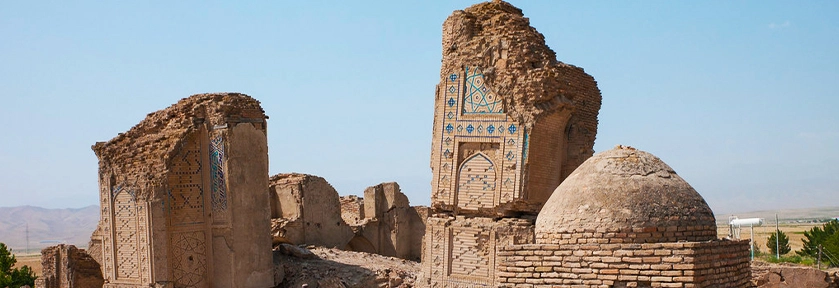Sayyid Jamal al-Din Mosque
Monument Location: White Wheat District, Akhal Province.
Monument Date: 15th century C.E.
Known as the Seyitjemaleddin Metjidi, this mosque is a truly elaborate saga that served as a mosque, governor, madrasah, and hanaka.
The beginning of the study of the Einstein text was initiated by V.A. Zhukovsky (1886). In 1904, the ruins were destroyed by R. Pompelin’s American expedition. In the conditions of Soviet Turkmenistan, in the 1920s, A.A. Karelin and V.R. Tripolsky investigated the causes of collapse and collapse, and S.S. Sklyarovsky carried out the designs. At different times, revolutionary measures (V.R.Tripolsky, N.M.Bachinsky) were also carried out. In 1947, the South Turkmenistan Archaeological Expedition (GTAKE) under the leadership of M.E. Masson carried out a deep and comprehensive study of the site.
Above the peshtid of the mosque, a large inscription bearing the name of Sultan Abul-Qasim-Babar (1446-1457), the ruler of Khorasan, reads: “This building was built during the reign of the great Sultan, the lord of his peoples, the protector of lands and ages, Abul-Qasim-Babar Bahadurkhan, may the Most High Himself perpetuate his authority and his kingdom.”
Other records tell us that the House of Beauty was built by a man named Muhammad with his own funds for the monument of his father, Jamal-ed-world-wa-d-d-d, in 1455-1456.
G.A. Pugachenkova confirmed that the inscription on the inscription on the mosque identified Muhammad as Muhammad Goddot, the former official of the sultanate, and she herself determined that the place of birth of her father, Dzhemaleddi, who was buried here, was Enev. The saga was not completed, for after the death of Sultan Babar (1457) a period of internecine warfare and destruction began. Built of finely baked bricks, the mosque is decorated with a sponge. The ceiling faces north, and the south wall of the house is decorated with ornaments. On the sides of the south wall are thin planks that are projected to the outside of the wall. The other two walls of the mosque have two wide, deep planks each. The decoration of the peacock was of great artistic value, depicting two eerie dragons with their heads stretched out towards each other. Their yellowish-brown body wafts over a bed of dark blue ornaments with a small floral embroidery, which begins at the open mouth of each of the creatures.
There are no other examples of dragons being depicted in a religious shrine in Central Asia. Despite the fact that dragon painting is deeply rooted in the history of Central Asian art, a definitive explanation of the origins of Enui painting has not yet been found. A more convincing explanation of the meaning of the depiction of dragons in the Enev text is given by G.A. Pugachenkova, who believes that “it itself is the totem of the main Turkmen tribe that lived in the Enev region in the 15th century, and it is possible that Sheikh Jalaluddin was buried in Enev, from which he belonged.”
The idea of the local origin of the totem (a religious symbol of the tribe) is further reinforced by the fact that the embroidery of the peshtag and the Arabic script on it, as well as the dragons, are found nowhere else in the architectural monuments of Central Asia. At the same time, the forms of this embroidery are characteristic of the pottery of the Turkmen Eneolithic (copper-copper period) and continue to exist in Turkmen carpet art to this day. All this allows us to consider the decoration of the Enveh Mosque as the very essence of the artistic tone inherited by the Turkmen people from their ancestors in ancient times.

